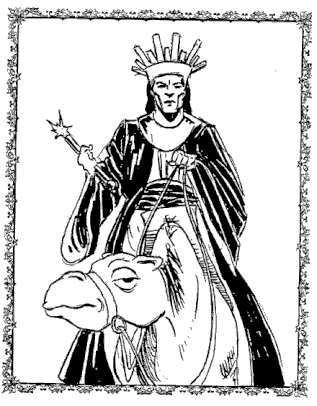King Paimon – Elegance Of Royalty
By James Donahue
He is listed as the ninth Goetia Spirit, but if there is a demon displaying a power to rival that of Bael, it is probably Paimon. This guy is among the most difficult spirits to summon and it is said that when he appears, he comes in elegant garb, with a sound of music and with a contingent of accompanying spirits.
Nineteenth Century magician and author S. L. MacGregor Mathers wrote that Paimon was “once of the Order of Dominations” before his alleged fall from Heaven. He noted that Paimon is so powerful he rules over 200 legions of demons.
When summoned, Mathers wrote, “he appears in human form with a crown on his head and is accompanied by hosts of spirits playing music. If offerings are made to him, two kings named Labal and Abalim will accompany him, along with others in the Order of Potentates in his host and 25 legions.”
It is said that Paimon shows himself as a powerful man with a woman’s face. Some of the early writers said this spirit might appear riding a dromedary with a host of demons, also appearing as men, playing trumpets, cymbals and other kinds of musical instruments.
Paimon’s crown is described as gold with an elegant assortment of bright stones.A serpent twines through the points of the crown. Our son, who evoked this demon in about 2003, said Paimon appeared wearing fine bright red garments with a white, embroidered collar that shined as if decorated with rare gems.
Hebrew legend has it that Paimon also is known Ozazl, or Azazel, a name found in the Old Testament Book of Leviticus. The name refers to one of the chief demons. The name meant “scapegoat” or a sacrificial goat sent by the high priest off into the wilderness to carry away the iniquities of the people.
Sixteenth Century occultist and demonologist Johann Wier wrote that Paimon “sitteth on a beast called a dromedarie which is a swift runner, and weareth a glorious crowne.” It was Wier’s belief that the arrogance expressed by Paimon resembled the pride that led to the fall of Lucifer.
Indeed, demonologists depict Paimon as one of the Kings of Hell and “more obedient to Lucifer” than all of the others.
Occultist Collin de Plancy’s Dictionnaire Infernal, published in 1863, states that Paimon roars in a loud voice when he first appears, “until the conjurer compels him and then he answers clearly the questions he is asked.”
It is written that Paimon teaches all arts, philosophy and sciences, and secret things. “He can reveal all mysteries of the Earth, wind and water, what the mind is, and everything the conjurer wants to know, gives good familiars, dignities and confirms them, binds men to the conjurer’s will.”
It should not be surprising, based on the way Paimon makes his kingly appearance, that this spirit “gives and confirms dignity.”
By James Donahue
He is listed as the ninth Goetia Spirit, but if there is a demon displaying a power to rival that of Bael, it is probably Paimon. This guy is among the most difficult spirits to summon and it is said that when he appears, he comes in elegant garb, with a sound of music and with a contingent of accompanying spirits.
Nineteenth Century magician and author S. L. MacGregor Mathers wrote that Paimon was “once of the Order of Dominations” before his alleged fall from Heaven. He noted that Paimon is so powerful he rules over 200 legions of demons.
When summoned, Mathers wrote, “he appears in human form with a crown on his head and is accompanied by hosts of spirits playing music. If offerings are made to him, two kings named Labal and Abalim will accompany him, along with others in the Order of Potentates in his host and 25 legions.”
It is said that Paimon shows himself as a powerful man with a woman’s face. Some of the early writers said this spirit might appear riding a dromedary with a host of demons, also appearing as men, playing trumpets, cymbals and other kinds of musical instruments.
Paimon’s crown is described as gold with an elegant assortment of bright stones.A serpent twines through the points of the crown. Our son, who evoked this demon in about 2003, said Paimon appeared wearing fine bright red garments with a white, embroidered collar that shined as if decorated with rare gems.
Hebrew legend has it that Paimon also is known Ozazl, or Azazel, a name found in the Old Testament Book of Leviticus. The name refers to one of the chief demons. The name meant “scapegoat” or a sacrificial goat sent by the high priest off into the wilderness to carry away the iniquities of the people.
Sixteenth Century occultist and demonologist Johann Wier wrote that Paimon “sitteth on a beast called a dromedarie which is a swift runner, and weareth a glorious crowne.” It was Wier’s belief that the arrogance expressed by Paimon resembled the pride that led to the fall of Lucifer.
Indeed, demonologists depict Paimon as one of the Kings of Hell and “more obedient to Lucifer” than all of the others.
Occultist Collin de Plancy’s Dictionnaire Infernal, published in 1863, states that Paimon roars in a loud voice when he first appears, “until the conjurer compels him and then he answers clearly the questions he is asked.”
It is written that Paimon teaches all arts, philosophy and sciences, and secret things. “He can reveal all mysteries of the Earth, wind and water, what the mind is, and everything the conjurer wants to know, gives good familiars, dignities and confirms them, binds men to the conjurer’s will.”
It should not be surprising, based on the way Paimon makes his kingly appearance, that this spirit “gives and confirms dignity.”
